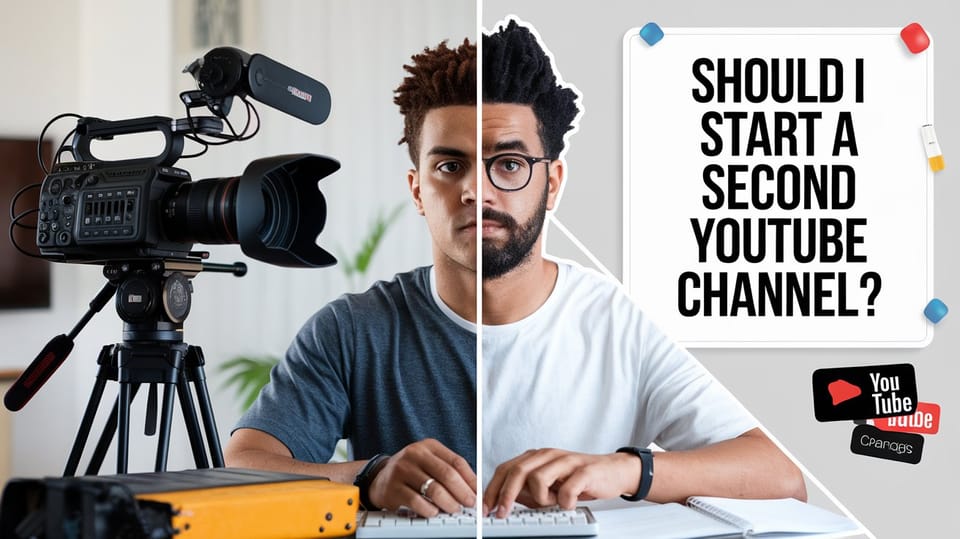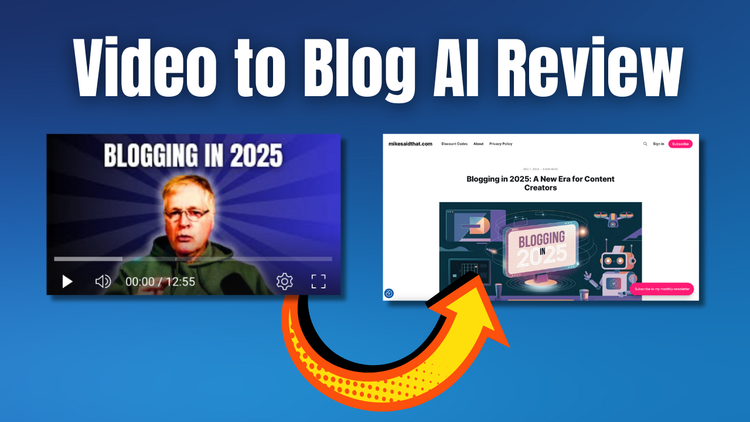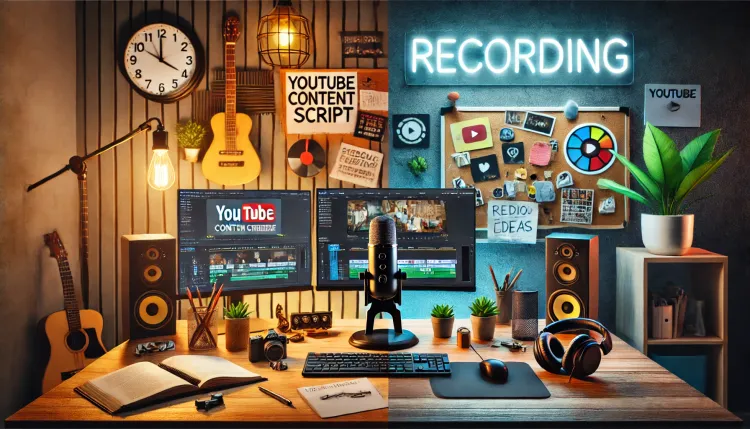Should I Start a Second YouTube Channel?

You know you have videos you'd like to create, but you are concerned they are too far outside of the niche of your main channel. You definitely don't want to confuse your current subscribers and possibly have them unsubscribe. If this is you, you'll have to ask yourself "Should I start a second YouTube channel"?
I've personally been looking into having more than one YouTube channel. It can bring new opportunities, but it also has its own problems. Let's look at the good and bad sides of having more than one YouTube channel.
YouTube lets creators have multiple channels. But just because you can, doesn't mean you should. The goal is to find the right mix for your content and viewers.
Having a second channel can really help once your main channel hits 5000 subscribers. At this point, you have enough experience creating and growing a subscriber base. You also know what types of videos your audience expects. This helps you determine if you need to start a second channel.
Key Takeaways
- YouTube allows multiple channels per creator
- A second channel can be beneficial for creators if you want to reach a new audience or approach a new channel niche
- Content diversification can open new opportunities for different channels
- Consider your time, resources and audience before starting a new channel so your established channel doesn't suffer because of a new project
Understanding the Motivation Behind Starting a Second Channel
When I look into youtube channel management, I see more creators starting second channels. They want to mix up their content. Let's see why they do it.
Exploring New Content Ideas
Starting a second channel will let you focus on new content niches without confusing the viewers of your main channel. When I've tried to create content that's outside of my niche on my main channel I've lost subscribers.
Plus a new channel will allow me to be creative. I can test out new ideas and ways of making videos. While maintaining two channels is definitely more work, it can also avoid issues with burn out, too. My idea for a second channel is a bit more eclectic which scratches my creative itch, while my main channel is more aligned with making money. In other words I have a "fun" channel and a "money" channel.
Reaching Different Audiences
A second channel lets me reach new people. I can make content for different interests. This way, I can attract viewers who might not watch my main channel. I also don't confuse my subscribers by uploading video topics too out of line with my niche.
This strategy helps me grow my viewership and get a more diverse fanbase. And I don't confuse the YouTube algorithm by creating content that doesn't fit in my niche.
Diversifying Income Streams
Having more than one channel can make money more stable. If my main channel makes a lot of money, I can use that to grow my new channel. This way, I can make more money through different ways.
| Motivation | Benefit | Consideration |
|---|---|---|
| Content Experimentation | Creative Freedom | Time Management |
| Audience Expansion | Increased Viewership | Content Consistency |
| Income Diversification | Financial Stability | Resource Allocation |
Before starting a new channel, I think about a few things. What's the purpose of this new channel? Can I really commit the time? Does it fit with my brand? Have I tried all ideas for my main channel? These questions help me decide.
Assessing Your Current Channel's Performance
Before starting a second YouTube channel, I must evaluate my current one. YouTube channel optimization is vital for growth. I'll start by examining my analytics dashboard for important metrics.
Views and watch time are essential. They show how many people watch my YouTube videos and for how long. But, I also need to look at audience retention. Are viewers watching the whole video, or do they leave early?
Engagement rates are also key. Comments, likes, and shares tell me if my content connects with viewers. It's not just about views; it's about building a community. Use your existing YouTube analytics to inform how you create content for your new niche.
Let's look at some important metrics I should check:
| Metric | Why It Matters |
|---|---|
| Watch Time | Shows total minutes viewed, more important than raw views |
| Audience Retention | Indicates how long viewers stay engaged |
| Click-Through Rate | Measures effectiveness of thumbnails and titles |
| Subscriber Growth | Indicates channel's overall appeal and growth |
Revenue is also important. Knowing my earnings helps me plan for the future. YouTube channel growth means more than just subscribers; it's about a sustainable business.
By carefully looking at these metrics, I'll understand my channel's good and bad points. This insight is key to deciding on a second channel or improving my current one.
Identifying Your Target Audience for the New Channel
Knowing your audience is key to a successful youtube channel strategy. Understanding who you're talking to can make or break your content. Let's dive into how to pinpoint your ideal viewers for your new channel.
Demographics and Psychographics
First, I look at who my viewers are to focus on one specific audience. Age, gender, location - these basics shape my content. But I dig deeper. What are their interests? Their values? This info helps me craft videos that really click with them.
Content Preferences
Next, I figure out what they like to watch. Short clips or long videos? Tutorials or vlogs? Knowing this guides my youtube content diversification. I make sure to give them what they crave.
Potential Overlap with Existing Audience
I always check if my new channel might steal views from my current one. It's tricky, but I aim to attract fresh faces while keeping my loyal fans happy.
| Audience Factor | Impact on Strategy | Action Item |
|---|---|---|
| Age Group | Content style and topics | Tailor videos to age-specific interests |
| Viewing Habits | Video length and posting schedule | Adjust content format to match preferences |
| Interests | Topic selection | Create content around popular themes |
By nailing down these details, I set myself up for success. It's not just about making videos - it's about making the right videos for the right people. This approach has helped me grow my channels and connect with viewers in meaningful ways.
Content Strategy for Your Second Channel
Creating a solid content strategy is vital for managing your new YouTube channel. With over 1 billion hours of YouTube content watched daily, it's important to stand out. I focus on making a variety of content that my audience loves.
My strategy includes:
- Keeping a regular upload schedule
- Trying out different video styles
- Making content that my audience wants to see
- Planning out content for both channels
I'm inspired by successful brands to mix up my content. For example, IBM has many content types and posts regularly. HubSpot posts new content every 2-4 days to keep their audience interested. I'm using these ideas to fit my channel's needs.
I'm also working on making my channel easier to find and subscribe to. By optimizing playlists, metadata, and descriptions, I'm helping more people discover my content. With over 500 hours of new content uploaded every minute, it's key to stand out.
By using a smart strategy for managing my YouTube channel and diversifying my content, I'm setting my second channel up for success. It's a competitive world, but with the right plan, I can shine.
Should I Start a Second YouTube Channel: Pros and Cons
I've been thinking about starting a second YouTube channel. It's a big decision. I've looked at the good and bad sides of having two channels.
Advantages of Multiple Channels
Starting a second channel can open up new chances. With over 30 million daily active users in the US, there's plenty of room to grow. Here are some benefits:
- Diversify content and reach new audiences
- Experiment with different video styles
- Increase your chances of making more money
Did you know that channels earning six figures annually rose by 40% year-over-year? That's a good reason to think about expanding.
Challenges and Possible Drawbacks
While growth is exciting, there are challenges to think about:
- More work and time needed
- Potential split of your current audience
- Starting over with no subscribers
It's important to know that over 60% of YouTube channels earn less than $500 in ad revenue per year. This shows the need for a good strategy before starting.
| Pros | Cons |
|---|---|
| Content diversification | Increased workload |
| New audience reach | Potential audience split |
| Income growth possibility | Starting from zero subscribers is challenging, but I’m determined to create a new channel. |
Whether to start a second channel depends on your goals, resources, and how well your current channel is doing. It's about finding a balance between growth and managing your workload.
Resource Management: Time, Energy, and Content Creation
Managing multiple YouTube channels is tough. It takes a lot of time, energy, and a good plan for managing your channels. When I started my second channel, I learned how important it is to use your resources well.
One thing that can save you a ton of time is to have a dedicated studio space. This means you already have all of your lighting set up, you have a background that doesn't require you to do a bunch of clean up every time you shoot a video and your camera(s) set up and dialed-in.
Consider batching your videos as well. Dedicate and prepare to shoot a series of videos in one sitting. This is particularly good when you shoot multiple video per week for each channel. Just change your clothing from one video to the next and nobody will know.
To do well with different content, I had to make a plan. I used content calendars, worked on videos in batches, and used tools to help me create a new channel. These steps helped me keep up with both channels without getting too tired.
Managing many channels means knowing what to do first. I made a table to show my weekly tasks:
| Day | Channel 1 | Channel 2 |
|---|---|---|
| Monday | Script Writing | Video Editing |
| Tuesday is when I plan to upload my latest YouTube video. | Filming for my new YouTube videos has become more efficient. | Thumbnail Creation |
| Wednesday | Editing | Script Writing |
| Thursday | SEO Optimization | Filming |
| Friday | Community Engagement | Promotion |
This plan helps me manage my YouTube channels well. It makes sure both channels get the right amount of work. Always remember, it's better to have quality than a lot of content. You should know your limits and plan your content wisely.
To keep my energy up, I take breaks and take care of myself. This stops me from getting too tired and keeps my ideas fresh. With these steps, I've been able to handle many channels and grow my audience.
Branding Considerations for Your New Channel
YouTube channel branding is key to making your content stand out. When starting a second channel, aim for a unique identity. Yet, keep it consistent with your main brand.
Visual Identity
Your visual identity is vital for promoting your channel. Choose a logo that looks good on all screens. Pick colors and fonts that show your channel's personality.
Remember, 70% of consumers buy from brands they see on YouTube. So, your visual elements are important.
Channel Name and Description
Choose a channel name that fits your content and appeals to your audience. Make your channel description clear and short. It should tell viewers what to expect.
This helps promote your channel and attract subscribers.
Cross-Promotion Strategies
Use your existing audience to grow your new channel. Mention your second channel in your main channel's videos. Use end screens and cards to link to your new content.
Cross-promotion can greatly help your branding efforts.
| Branding Element | Importance | Tips |
|---|---|---|
| Logo | High | Versatile, recognizable |
| Colors | Medium | Reflect channel personality |
| Typography | Medium | Consistent across videos |
| Channel Banner | High | Showcase brand message |
| Thumbnails | Very High | Eye-catching, consistent style |
By focusing on these branding elements, you'll lay a solid foundation for your new channel's growth and success.
Monetization Strategies for Your Second Channel
Monetizing a YouTube channel is more than just making good videos. It's about using smart strategies too. For my second channel, I'm exploring different ways to make money.
First, I'm working to meet YouTube's Partner Program rules. I need 1,000 subscribers and 4,000 watch hours in 12 months. Once I hit these marks, I can earn from ads. Creators get 55% of ad money, which is a big deal BUT to make much you need quite a few views per video.
- Channel memberships (available at 30,000 subscribers)
- Super Chat during live streams (viewers can tip up to $500!)
- Merchandise shelf (for channels with 10,000+ subscribers)
Optimizing your YouTube channel is important to unlock these options. I'm keeping my uploads regular, engaging with my audience, and promoting on other platforms. It's hard work, but it could pay off big time.
It's all about giving value, not just chasing views. I'm building a loyal fan base. This takes time, but it's essential for lasting success in making money on YouTube.
Alternative Options to Starting a Second Channel
I've looked into many ways to make a YouTube channel better, and starting a second channel isn't always the best. There are other good ways to mix up your content.
One way is to slowly add new content to your current channel. This lets you see if people like it without starting a new channel. You can use playlists to group different types of content, making it easier for viewers to find what they like.
Another idea is to change how you make content. You could make your niche a bit bigger or explore related topics. For example, a tech channel could start talking about lifestyle tech or smart homes.
Consider a video that just tells your audience you'll be occasionally sharing information on a new topic. The key thing is that it needs to be loosely associated with your niche. For example, if your niche was mainly blogging explain you are going to explore other areas of content creation like social media and YouTube.
Working with other channels or being a guest can also help you reach more people. This way, you can get into new audiences without starting a new channel. It lets you use the viewers of other channels to find your own.
"Diversifying content within the same channel can confuse subscribers and impact views and revenue. It's important to have a good plan before trying new things."
Here's a look at different ways to mix up your content:
| Approach | Pros | Cons |
|---|---|---|
| Second Channel | Clear audience segmentation | Requires additional resources |
| Gradual Content Expansion | Retains existing audience | Slower growth in new areas |
| Collaborations | Immediate exposure to new audiences | Limited control over content |
| Themed Playlists | Organizes diverse content | May not attract new viewers as effectively |
The best choice depends on what you want to achieve and who you're making content for. Think about these options before deciding to start a second channel.
Conclusion
Hopefully, after reading this blog post you'll be able to answer the question "Should I start a second YouTube channel?" What you decide to do really depends on your own situation. If you truly think some of your new content ideas will confuse the YouTube algorithm and confuse your subscribers, it means you need to start another channel.
If you do start another channel, just make sure it has a clear focus and niche. Remember, success on YouTube is about making content that's valuable and meets your audience's needs regardless of topic or niche.
Frequently Asked Questions
Here's an extended FAQ for "Should You Start a Second YouTube Channel?" with the requested format and terms:
Should I start a second YouTube channel in 2024?
Starting a second YouTube channel in 2024 can be a great idea if you have diverse content that doesn't fit your main channel's theme. It allows you to explore new topics without confusing your existing audience.
How do I find the perfect niche for my new YouTube channel?
To find the perfect niche for your new channel, consider your passions, expertise, and audience interests. Research trending topics and analyze gaps in the market. You can also use tools like Google Trends or YouTube's search suggestions to discover popular topics.
Can I use the same content across multiple YouTube channels?
While it's possible to repurpose content across channels, it's generally not recommended to use identical content on multiple YouTube channels. This can lead to issues with YouTube's algorithm and potentially violate their policies. Instead, create unique content for each channel that caters to its specific audience and theme.
How do I manage the workload of running two channels?
Managing two YouTube channels can be challenging. To handle the workload effectively, create a content calendar, batch produce videos, and consider outsourcing tasks like editing or thumbnail creation. Use tools to schedule uploads and manage comments. Remember, consistency is key, so ensure you can maintain a regular posting schedule for both channels.
Should I create a transcript for my YouTube videos?
Yes, creating a transcript for your YouTube videos is highly recommended. Transcripts improve accessibility, help with SEO, and allow viewers to follow along even without sound. They can also be repurposed for blog posts or show notes, providing additional value to your audience.
How do I promote my new YouTube channel without neglecting my old channel?
To promote your new channel while maintaining your old one, consider cross-promotion. Mention your new channel in videos on your established channel, use end screens to link to it, and share it on your social media platforms.
Is it better to have separate channels for different topics or keep everything on one channel?
The decision to have separate channels for different topics or keep everything on a single channel depends on your content and audience. If the topics are vastly different (e.g., gaming and cooking), separate channels might be better to avoid confusing subscribers. However, if the topics are related or your audience enjoys diverse content, a single channel could work well. Consider surveying your audience to gauge their preferences.



